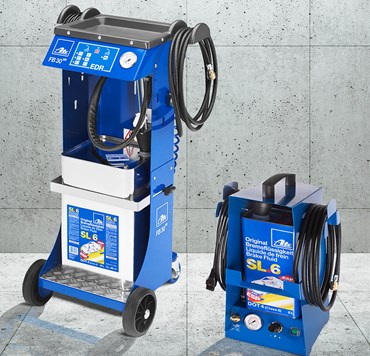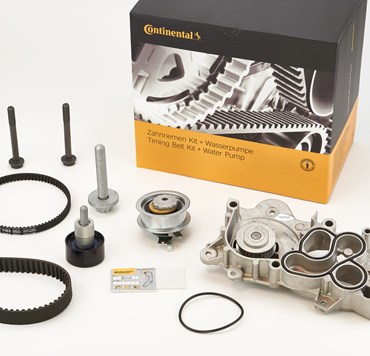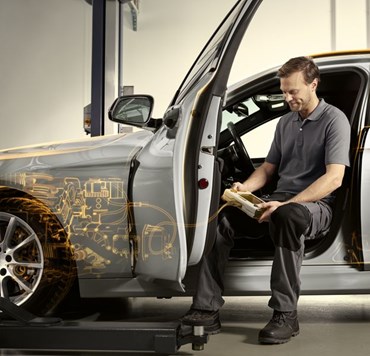Winter is here – with lots of snow and sub-zero temperatures. The car battery can go on strike. Our battery comparison will tell you how to help your customers avoid this problem, and how they can get through winter with the right equipment.
Preventive battery check for more customer satisfaction
Nothing is more annoying for your customers: The car has just been in the workshop, but just in time for the first cold snap, the battery goes on strike. To avoid this problem, always take a quick look at the battery voltage in winter – even if your customers come to you for something completely different. Everyone will be happy about this small extra service and will certainly stop by again next time.
Be sure about the batteries you choose: How to give the right advice to your customers
What if your check reveals that a new battery is needed? What can you recommend to your clients in this case? A starter battery, an EFB (Enhanced Flooded Battery) or an AGM (Absorbent Glass Mat Battery)? Nowadays, there are various ways to equip vehicles with the power they need – but not all the available combinations make sense.
For vehicles without a start-stop system, a good starter battery with lead-acid technology is quite sufficient. Continental’s starter battery, for example, can withstand extreme temperatures. For example, their cold-start performance is 100%, making them ideal for use in sub-zero temperatures.
On the other hand, for vehicles with a start-stop system an EFB is recommended, since vehicle manufacturers also install them. Our EFB can handle around twice as many charge cycles as a normal starter battery and has a cold start performance of 115%.
For vehicles with a start-stop system and recuperation, you should choose an AGM battery. The glass nonwoven absorbs the acid in the battery, giving it a high level of cycle stability. Continental’s AGM battery is extremely leak-proof and its cold-start performance is 135%.
Continental batteries compared
| Criteria | EFB battery | AGM battery | Starter battery |
|---|---|---|---|
| Vehicle type | Start-stop | Start-stop and recuperation | Without start-stop (gasoline/diesel vehicles) |
| Cycle stability | >> 200 %* | >> 300 %* | 100 % |
| Technology | EFB – Enhanced Flooded Battery | AGM – Absorbent Glass Mat | Lead-acid |
| Maintenance | Maintenance-free | Maintenance-free | Low maintenance |
| Number of battery types | 6 | 3 | 10 |
| Cold start capacity | 115 %* | 135 %* | 100 % |
| Specification | OE-equivalent | OE-equivalent | OE-equivalent |
| Quality level | OEM quality | OEM quality | OEM quality |
| Suitable for recuperation | - | Yes | - |
| Deep discharge | Good | Very good | - |
| Vibration protection | Good | Very good | - |
| Charge acceptance | Good | Very good | - |
| Charge indicator (Magic Eye) | Yes | - | Yes |
| Leak proof | Yes | Yes | - |
| Warranty | 2 years | 2 years | 2 years |
When is it worth upgrading to a better battery?
The bottom line here is that when you install a new battery, it should never be a downgrade. Cars that had an AGM battery, for example, should be given a new AGM battery – and the same applies to vehicles with an EFB battery that has to be changed. Theoretically, upgrading a battery is always possible, but it doesn’t always make sense. For cars without a start-stop system, for example, it’s just not worth switching to an EFB battery.
However, if your EFB customers often drive in heavy city traffic with a lot of stop-and-go, a change to AGM is a possibility, because these batteries are still somewhat better adjusted to more demanding start-stop situations. From a purely temperature point of view, however, switching from an EFB to an AGM battery is only worthwhile if the car is often in higher regions where the air is a lot colder. In milder latitudes, an EFB battery will do the job. Feel free to ask your customers where they mainly use their vehicles and explain your recommendations.
Here’s what to bear in mind when installing a battery
The installation of the different types of batteries is basically not witchcraft and you’re already familiar with this task. However, some vehicle manufacturers provide for hoses to be connected to the flame check valves of the batteries – so always check the manual to be sure. Some vehicles also require the battery to be taught via a diagnostic tool. This is also done in just a few simple steps, but it’s something that you should also bear in mind.
All the details about Continental batteries
Our product brochures will show you all the features that distinguish our different battery types with OE qualities. They make interesting reading!
Do you want to be regularly informed about exciting topics in the aftermarket? Subscribe to the newsletter




